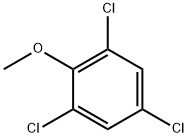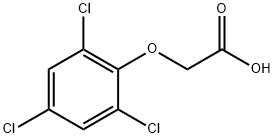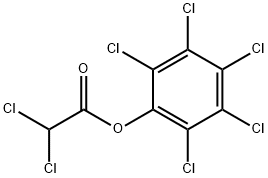2,4,6-TRICHLOROANISOLE
Synonym(s):2,4,6-Trichloro-1-methoxybenzene
- CAS NO.:87-40-1
- Empirical Formula: C7H5Cl3O
- Molecular Weight: 211.47
- MDL number: MFCD00000588
- EINECS: 201-743-5
- SAFETY DATA SHEET (SDS)
- Update Date: 2025-01-27 09:38:02

What is 2,4,6-TRICHLOROANISOLE?
Description
2,4,6-Trichloroanisole (TCA), first synthesized by M. Kohn and M. Heller in 1925, was formerly used as an “assistant” in polyester fiber dyeing. It is also a fungal metabolite produced from the fungicide 2,4,6-trichlorophenol.
TCA, however, is mainly known for causing cork taint that can give wine a musty smell and taste. Until recently, the prevailing wisdom was that it was generated by molds in contaminated corks. But H. Takeuchi and T. Kurahashi of Osaka University (Japan) discovered that?TCA contaminates many foods and beverages?and that it blocks a protein ion channel associated with olfactory sensing. It may also cause foods to spoil, which would intensify their off-taste.
Chemical properties
white or off-white fibrous powder. Insoluble in water; soluble in benzene, methanol, and dioxane; gradually sublimes at room temperature.
The Uses of 2,4,6-TRICHLOROANISOLE
2,4,6-Trichloroanisole is used in method for reducing odor in room in remodeling work by removing causative substances.
The Uses of 2,4,6-TRICHLOROANISOLE
Dyeing auxiliary for polyester fabrics.
Definition
ChEBI: A monomethoxybenzene that is 1,3,5-trichlorobenzene in which one of the hydrogens is replaced by a methoxy group.
General Description
2,4,6-Trichloroanisole (TCA) is responsible for the cork taint in wines. TCA has been quantitated in bark cork stoppers by supercritical fluid extraction (SFE) method. Degradation of TCA catalyzed by raw bauxite via ozonation in water has been investigated.
Properties of 2,4,6-TRICHLOROANISOLE
| Melting point: | 60-62 °C (lit.) |
| Boiling point: | 132 °C/28 mmHg (lit.) |
| Density | 1.6400 |
| refractive index | 1.5510 (estimate) |
| Flash point: | 11 °C |
| storage temp. | room temp |
| solubility | benzene: soluble(lit.) |
| form | powder to crystal |
| color | White to Almost white |
| Water Solubility | 13.2mg/L(25 ºC) |
| Merck | 13,9702 |
| BRN | 2329219 |
| Stability: | Stable. Incompatible with strong oxidizing agents. |
| CAS DataBase Reference | 87-40-1(CAS DataBase Reference) |
| EPA Substance Registry System | Benzene, 1,3,5-trichloro-2-methoxy- (87-40-1) |
Safety information for 2,4,6-TRICHLOROANISOLE
| Signal word | Warning |
| Pictogram(s) |
 Exclamation Mark Irritant GHS07 |
| GHS Hazard Statements |
H302:Acute toxicity,oral H319:Serious eye damage/eye irritation H413:Hazardous to the aquatic environment, long-term hazard |
| Precautionary Statement Codes |
P264:Wash hands thoroughly after handling. P264:Wash skin thouroughly after handling. P270:Do not eat, drink or smoke when using this product. P273:Avoid release to the environment. P280:Wear protective gloves/protective clothing/eye protection/face protection. P301+P312:IF SWALLOWED: call a POISON CENTER or doctor/physician IF you feel unwell. P305+P351+P338:IF IN EYES: Rinse cautiously with water for several minutes. Remove contact lenses, if present and easy to do. Continuerinsing. |
Computed Descriptors for 2,4,6-TRICHLOROANISOLE
New Products
4,4-Difluoropiperidine hydrochloride tert-butyl 9-methoxy-3-azaspiro[5.5]undecane-3-carboxylate Indole Methyl Resin N-Isopropylurea N,N-Dicyclohexylcarbodiimide(DCC) MELDRUMS ACID 5-METHYLISOXAZOLE-4-CARBOXYLIC ACID Magnessium Bis glycinate Zinc ascorbate 1-bromo-2-butyne 2-acetamidophenol 9(10H)-anthracenone Erythrosin B, 4-Piperidinopiperidine 2-((4-morpholinophenylamino) (methylthio) methylene) malononitrile 2,4-dihydroxybenzaldehyde 3-(4-morpholinophenylamino)-5-amino-1H-pyrazole-4-carbonitrile Methyl 2-methylquinoline-6-carboxylate 2,6-dichloro-4-nitropyridine 4-Bromo-2-chlorobenzonitrile 2-(benzylamino)acetic acid hydrochloride 4-(tert-Butoxycarbonylamino)but- 2-ynoic acid 3,4-dihydro-2H-benzo[b][1,4]dioxepine 1-Phenyl-1-cycloprppanecarboxylicacidRelated products of tetrahydrofuran








You may like
-
 2,4,6-Trichloroanisole CAS 87-40-1View Details
2,4,6-Trichloroanisole CAS 87-40-1View Details
87-40-1 -
 2,4,6-Trichloroanisole CAS 87-40-1View Details
2,4,6-Trichloroanisole CAS 87-40-1View Details
87-40-1 -
 2,4,6-Trichloroanisole solution CAS 87-40-1View Details
2,4,6-Trichloroanisole solution CAS 87-40-1View Details
87-40-1 -
 3-(4-amino-1-oxoisoindolin-2-yl)-1-methylpiperidine-2,6-dione 98%View Details
3-(4-amino-1-oxoisoindolin-2-yl)-1-methylpiperidine-2,6-dione 98%View Details -
 20677-73-0 (2,2-diethoxyethyl)methylamine 98%View Details
20677-73-0 (2,2-diethoxyethyl)methylamine 98%View Details
20677-73-0 -
 3-(4-(hydroxyamino)-1-oxoisoindolin-2-yl)piperidine-2,6-dione 98%View Details
3-(4-(hydroxyamino)-1-oxoisoindolin-2-yl)piperidine-2,6-dione 98%View Details -
 57381-49-4 2-bromo-4-chlorobenzonitrile 98%View Details
57381-49-4 2-bromo-4-chlorobenzonitrile 98%View Details
57381-49-4 -
 4,6-dichloropyrimidine-5-carbaldehyde 98%View Details
4,6-dichloropyrimidine-5-carbaldehyde 98%View Details
5305-40-8
